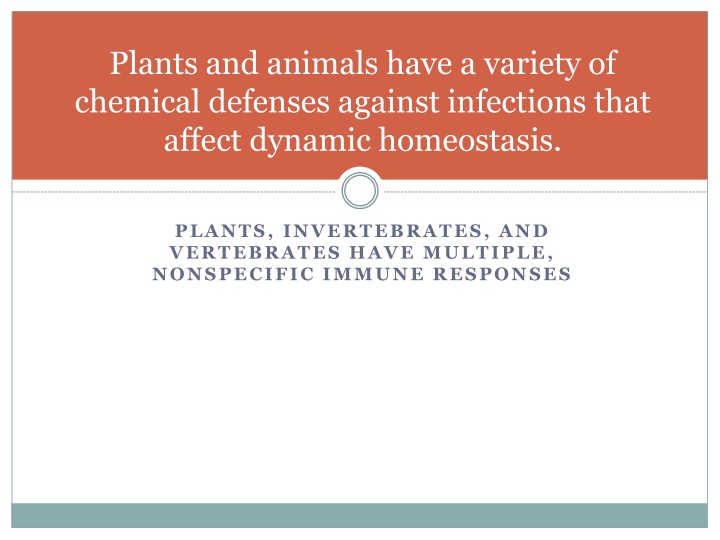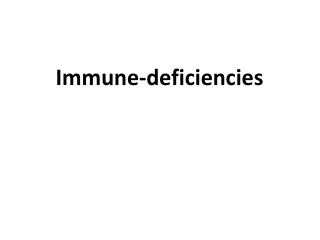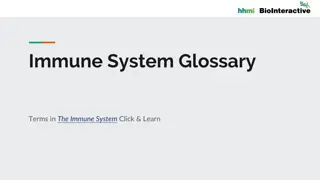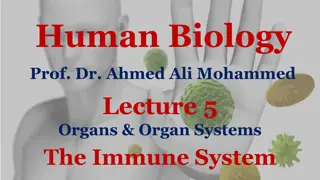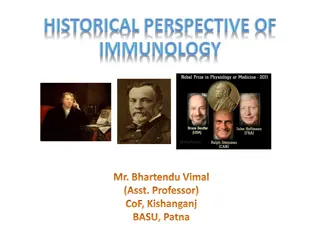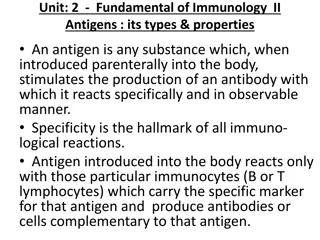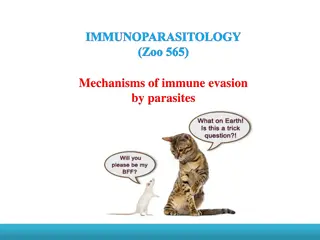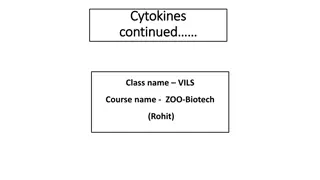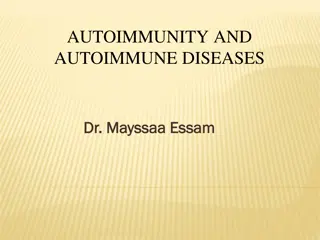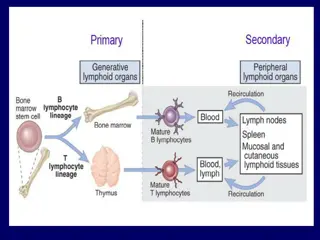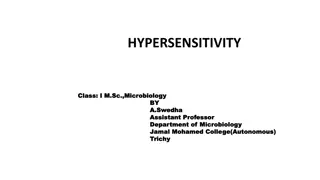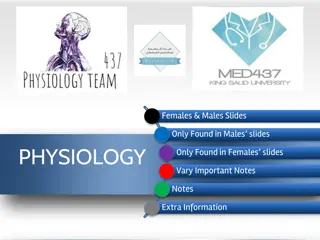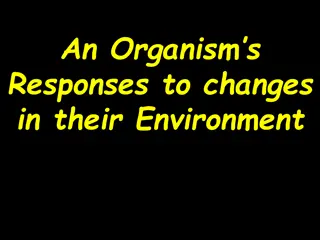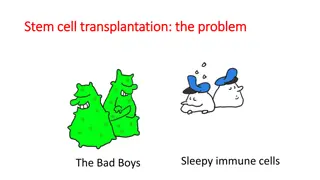Immune Responses in Plants and Animals: A Comprehensive Overview
Plants and animals have evolved a variety of chemical defenses to combat infections and maintain homeostasis. Innate immunity provides immediate protection through barrier and internal defenses, while acquired immunity offers specific responses involving humoral and cell-mediated mechanisms. Plants exhibit systemic acquired resistance, while invertebrates primarily rely on innate immunity for defense against pathogens.
Download Presentation

Please find below an Image/Link to download the presentation.
The content on the website is provided AS IS for your information and personal use only. It may not be sold, licensed, or shared on other websites without obtaining consent from the author.If you encounter any issues during the download, it is possible that the publisher has removed the file from their server.
You are allowed to download the files provided on this website for personal or commercial use, subject to the condition that they are used lawfully. All files are the property of their respective owners.
The content on the website is provided AS IS for your information and personal use only. It may not be sold, licensed, or shared on other websites without obtaining consent from the author.
E N D
Presentation Transcript
Plants and animals have a variety of chemical defenses against infections that affect dynamic homeostasis. PLANTS, INVERTEBRATES, AND VERTEBRATES HAVE MULTIPLE, NONSPECIFIC IMMUNE RESPONSES
Fig. 43-2 Pathogens (microorganisms and viruses) INNATE IMMUNITY Barrier defenses: Skin Mucous membranes Secretions Recognition of traits shared by broad ranges of pathogens, using a small set of receptors Internal defenses: Phagocytic cells Antimicrobial proteins Inflammatory response Natural killer cells Rapid response ACQUIRED IMMUNITY Humoral response: Antibodies defend against infection in body fluids. Recognition of traits specific to particular pathogens, using a vast array of receptors Cell-mediated response: Cytotoxic lymphocytes defend against infection in body cells. Slower response
Innate Immunity Innate immune responses are active immediately upon infection are the same whether or not the pathogen has been encountered previously Innate immunity includes: Barrier defenses such as skin, mucous membranes, & secretions Internal defenses such as phagocytic cells, antimicrobrial proteins, inflammatory response & natural killer cells
Plants Epidermis is a plants first line of defense (or periderm in woody plants) If a pathogen successfully infects a plant cell, the plant can recognize invading pathogens and defend against them by chemical attack Hypersensitive response upon infection by some pathogens a signal transduction pathway triggers a programmed death to infected cells http://www.ru.nl/publish/pages/575050/no.jpg
Plants Systemic Acquired Resistance: localized and specific; a containment response based on gene-for-gene recognition between host and pathogen Methylsalicyclic acid is carried throughout the plant via the phloem; at the site of the infection it is converted to salicylic acid which activates signal transduction to produce proteins to resist pathogen attach
Invertebrates Only form of defense is Innate Immunity Boundary defense: Outer boundaries (i.e. exoskeleton or skin) 1st line of defense Lysozyme enzyme found in gut; digest microbial cell walls Low pH further protects digestive system Internal defense: phagocytic cells (hemocytes) engulf and destroy invaders Secreting cells are triggered by signal transduction pathways to produce chemicals (including antimicrobial peptides) that kill, trap and/or inactivate microbes
Fig. 43-3 Microbes PHAGOCYTIC CELL Vacuole Lysosome containing enzymes
Vertebrates Barrier Defenses: skin and mucous membranes block entry Mucous traps microbes and cilia sweep it away Saliva, tears and mucus: contain lysozyme to destroy and wash away microbes Acidic environment of stomach, skin and sweat prevent growth of microbes
Vertebrates Cellular Defenses: Toll-like receptors (TLR) membrane receptors recognize components found in microbes; upon contact with microbe TLR trigger a series of internal defenses beginning with phagocytosis Phagocytic cells include NEUTROPHILS - most abundant; engulf and destroy microbes MACROPHAGES big eaters; large cells that migrate through the body or permanently reside in certain organs; well positioned to fight microbes ESINOPHILS defend against multi-cellular invaders (i.e. parasitic worms) by releasing destructive chemicals DENDRITIC cells - stimulate acquired immunity against invaders
Vertebrates Cellular Defenses Antimicrobial peptides and proteins INTERFERONS secreted by virus infected body cells inducing nearby uninfected cells to produce substances that inhibit viral reproduction (LIMIT CELL TO CELL SPREAD) COMPLEMENT SYSTEM roughly 30 proteins found in blood plasma; circulate in an inactive form; upon contact with microbes they become active; activation involves a series of actions that results in the lysis of the invading cells NATURAL KILLER CELLS target and destroy cells that have been infected; preventing spread of disease to healthy cells
Mast Cells connective tissue cells that store chemicals for secretion Histamine is released by mast cells at sites of damage triggers blood vessels to dilate and become permeable Activated macrophages release more signaling molecules to further increase blood flow Increased blood supply causes redness, heat & swelling Vertebrates Antimicrobrial proteins , complement systems, phagocytes, etc arrive via blood stream to destroy the invader which results in the accumulation of pus (fluid of WBC, dead microbes, & cell debris) Inflammatory Response: changes brought about by signaling molecules released upon injury or infection
Plants and animals have a variety of chemical defenses against infections that affect dynamic homeostasis. MAMMALS USE SPECIFIC IMMUNE RESPONSES TRIGGERED BY NATURAL OR ARTIFICIAL AGENTS THAT DISRUPT DYNAMIC HOMEOSTASIS
Acquired Immunity WHITE BLOOD CELLS CALLED LYMPHOCYTES RECOGNIZE AND RESPOND TO ANTIGENS, FOREIGN MOLECULES LYMPHOCYTES THAT MATURE IN THE THYMUS ABOVE THE HEART ARE CALLED T CELLS LYMPHOCYTES THAT MATURE IN BONE MARROW ARE CALLED B CELLS
Immune System Tonsils and adenoids protect by trapping germs that enter through your mouth and nose Thymus produces T-cells Spleen filters blood looking for foreign cells Bone Marrow produces new RBC and WBC from stem cells; where B-cells are formed Appendix may serve as a storehouse for good bacteria Lymph clear / white made of WBC particularly lymphocytes Lymph Nodes - found throughout the body help recognize and fight infections; contain B, T and other immune cells Lymphatic vessels mirror the blood stream so that it can send out immune cells when needed Peyer s Patches -oval elevated patches of closely packed lymph follicles on the mucosa of the small intestines.
B cells and T cells have receptor proteins that can bind to foreign molecules Each individual lymphocyte is specialized to recognize a specific type of molecule An antigen is any foreign molecule to which a lymphocyte responds A single B cell or T cell has about 100,000 identical antigen receptors Antigen Receptors All antigen receptors on a single lymphocyte recognize the same epitope, or antigenic determinant, on an antigen
B cell receptors bind to specific, intact antigens The B cell receptor consists of two identical heavy chains and two identical light chains The tips of the chains form a constant(C) region, and each chain contains a variable (V) region, so named because its amino acid sequence varies extensively from one B cell to another B cells give rise to plasma cells, which secrete proteins called antibodies or immunoglobulins Secreted antibodies, or immunoglobulins, are structurally similar to B cell receptors but lack transmembrane regions that anchor receptors in the plasma membrane
T cells bind to antigen fragments presented on a host cell These antigen fragments are bound to cell-surface proteins called MHC molecules MHC molecules are so named because they are encoded by a family of genes called the major histocompatibility complex In infected cells, MHC molecules bind and transport antigen fragments to the cell surface, a process called antigen presentation A nearby T cell can then detect the antigen fragment displayed on the cell s surface
The binding of a mature lymphocyte to an antigen induces the lymphocyte to divide rapidly This proliferation of lymphocytes is called clonal selection Two types of clones are produced: short-lived activated effector cells and long-lived memory cells Clonal Selection
The first exposure to a specific antigen represents the primary immune response During this time, effector B cells called plasma cells are generated, and T cells are activated to their effector forms In the secondary immune response, memory cells facilitate a faster, more efficient response Second Exposure
Mammalian Immune System Humoral Response Cell Mediated Response involves activation and clonal selection of cytotoxic T cells Specific immunity brought about by T cells; fights body cells infected with pathogens; promotes phagocytosis by other white blood cells involves activation and clonal selection of B cells, resulting in production of secreted antibodies Specific immunity brought about by antibody producing B cells; fights bacteria and viruses in body fluids Helper T cells aid both responses
Fig. 43-16 Humoral (antibody-mediated) immune response Cell-mediated immune response Key Antigen (1st exposure) + Stimulates Gives rise to Engulfed by Antigen- presenting cell + + + B cell Helper T cell Cytotoxic T cell + + Memory Helper T cells + + + Antigen (2nd exposure) Memory Cytotoxic T cells Active + Plasma cells Memory B cells Cytotoxic T cells Secreted antibodies Defend against extracellular pathogens by binding to antigens, thereby neutralizing pathogens or making them better targets for phagocytes and complement proteins. Defend against intracellular pathogens and cancer by binding to and lysing the infected cells or cancer cells.
Helper T Cells A surface protein called CD4 binds the class II MHC molecule This binding keeps the helper T cell joined to the antigen- presenting cell while activation occurs Activated helper T cells secrete cytokines that stimulate other lymphocytes
Killer T Cell Cytotoxic T cells are the effector cells in cell- mediated immune response Cytotoxic T cells make CD8, a surface protein that greatly enhances interaction between a target cell and a cytotoxic T cell Binding to a class I MHC complex on an infected cell activates a cytotoxic T cell and makes it an active killer The activated cytotoxic T cell secretes proteins that destroy the infected target cell
B Cells The humoral response is characterized by secretion of antibodies by B cells Activation of B cells is aided by cytokines and antigen binding to helper T cells Clonal selection of B cells generates antibody-secreting plasma cells, the effector cells of humoral immunity
Neutralization occurs when a pathogen can no longer infect a host because it is bound to an antibody Opsonization occurs when antibodies bound to antigens increase phagocytosis Antibodies together with proteins of the complement system generate a membrane attack complex and cell lysis Antibodies: The five major classes of antibodies, or immunoglobulins, differ in distribution and function
Vaccines HTTP://WWW.TED.COM/TALKS/SETH_BERKL EY_HIV_AND_FLU_THE_VACCINE_STRATEG Y.HTML
